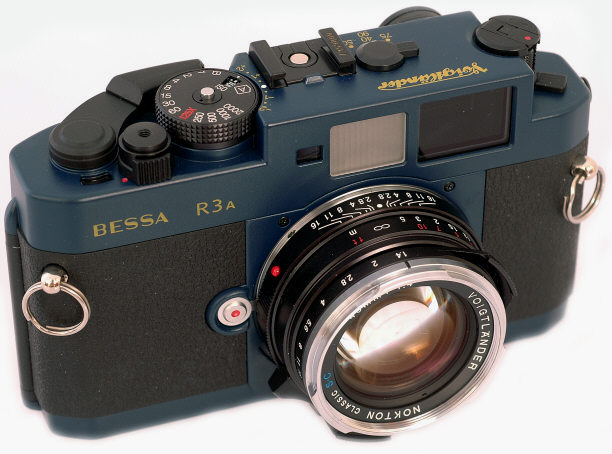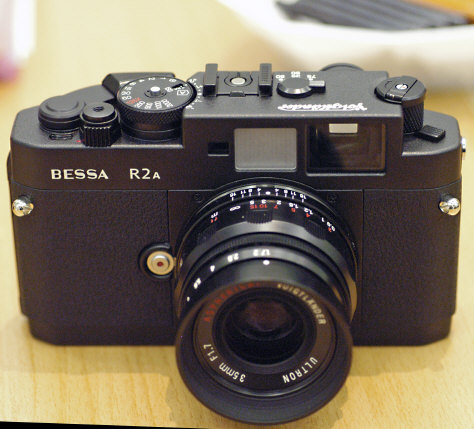Voigtlander Bessa R2A R3A (original) (raw)
CameraQuest Home Shopping Cart Price List Camera Articles I Buy / Wants Repairs Books Adapters
Voigtlander Bessa R2A or R3A 35mm Leica M Mount Rangefinders
classic electronic shutter 35mm film rangefinder bodies
Sadly all Voigtlander film cameras are discontinued and increasingly hard to find.
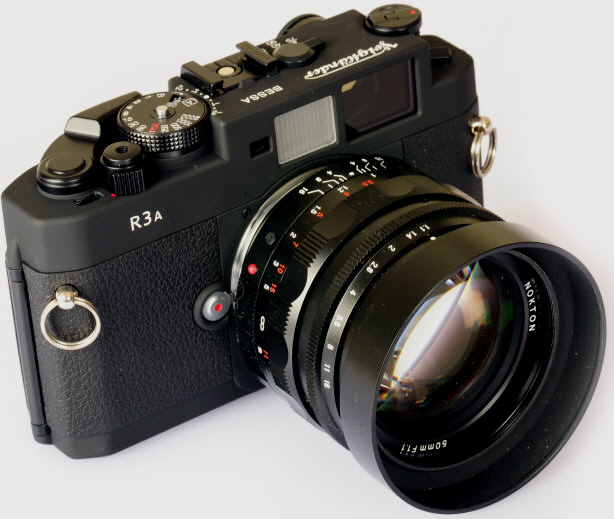
Black Voigtlander Bessa R3A w/ Super Speed 50/1.1 Nokton
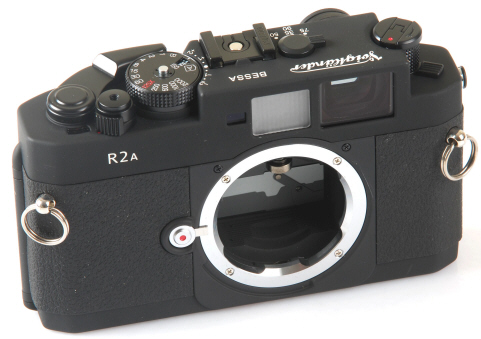
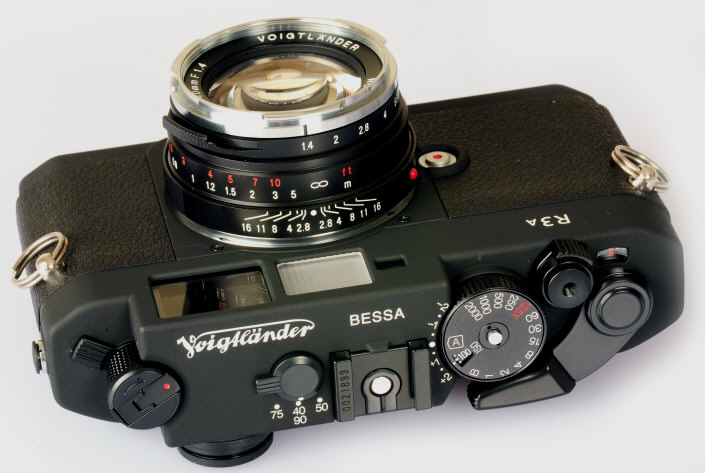
Black Voigtlander Bessa R3A w/ 40/1.4 Nokton
1:1 Life Size Magnification Viewfinder, 40/50/75/90 Framelines, Close Focus .7 Meter
Cologne Germany Photokina 2004: Cosina's President Mr. Kobayashi introduced his two new Voigtlander Bessa cameras, the R3A and R2A. Taking a new direction, these new cameras are Voigtlander's first Aperture Priority Leica M mount bodies. The R2A and R3A are Identical except for the finders, the R2A has a .7 magnification finder with 35/50/75/90 framelines while the R3A has a 1:1 finder with 40/50/75/90 framelines. The Bessa 3A is the first Leica M mount film camera with a life size 1:1 finder! The life size view finder allows photogs to shoot comfortably and effectively with both eyes open at the same time! The M mount was first introduced with the Leica M3 in 1953. It only took half a century and Mr. K (Mr. Rangefinder), to bring a 1:1 life size finder to the M mount world. As always, it was fascinating to meet with Mr. K and his staff to discuss the new cameras, and new ideas for future cameras. The R3A and R2A went on sale to the public July 5, 2005.
What's aperture priority? The photog sets the lens aperture, the camera sets the shutter speed. These cameras join a short list of only 3 previous Leica M mount AE film cameras: Minolta CLE,Konica Hexar RF, and the current $3600 Leica M7. Metered manual exposure is also possible. Many photogs find AE exposure gives them faster shooting and more pics in fast changing situations, such as events and street shoot.
Leica M mount Aperture Priority Rangefinder with 1:1 Finder, 40/50/75/90 Framelines, mounting the new Voigtlander 40/1.4 Nokton Classic M mount lens. With its large bright 1:1 VF/RF, an interesting argument can be made thatthe R3A has the best finder ever for 50, 75, and 90 framelines amongst film cameras, as all the other 1:1 film rangefinder cameras have dimmer finders, brightlines, and RF focusing patches. This is not surprising, as all the other 1:1 RF film cameras were all designed four decades ago or more.
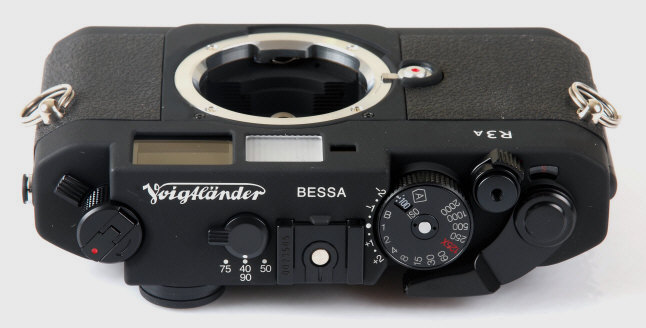
Note the frameline selector, automatic AE compensation dial, film ISO dial, AE selector, and red electronic sync. This is the current production matt black finish. Earlier R3A and R2A's have a black splatter paint finish.
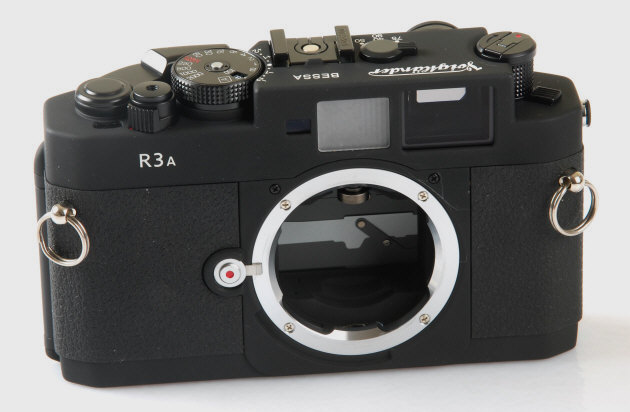
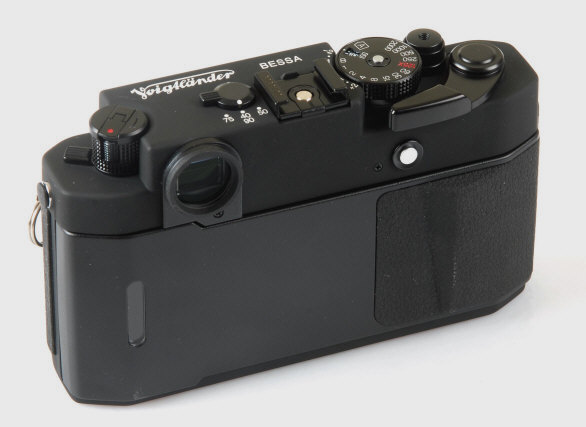
Note shutter lock which rotates around the shutter release
Notice the see thru film chamber on the back door, and the AE lock button on the back of the top plate.
Voigtlander Bessa R2A
.7 Magnification Viewfinder, 35/50/75/90 Framelines, Close Focus .7 Meter
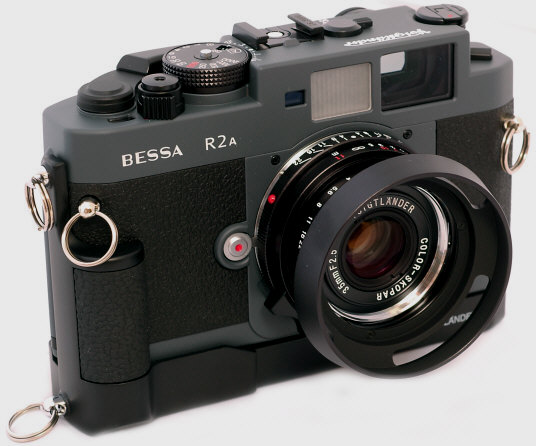
Discontinued gray paint Voigtlander Bessa R2A with 35/2.5 PII lens and Bessa Trigger Winder
Leica M mount Aperture Priority Rangefinder with .7 Finder, 35/50/75/90 Framelines
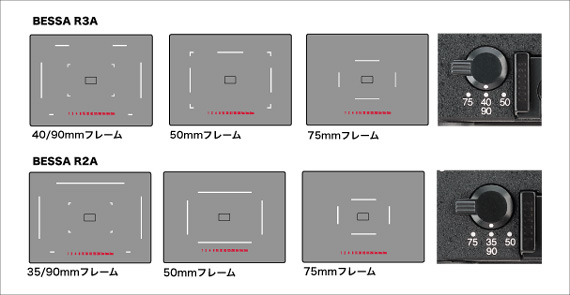
R2A / R3A framelines are shown above. The red line at the bottom indicates the LED shutter speed read out, 1, 2, 4, 8, 15, 30, 60, 125, 250, 500, 1000, 2000.
On AE, the exact speed is rounded off to the nearest standard shutter speed. On manual, the suggested speed is lit, while set speed blinks.
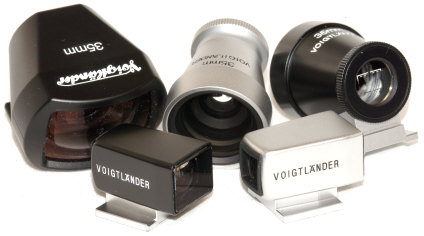
The Ultimate R3A Accessory? Perhaps the Voigtlander 28/35 Minifinder which adds 28 and 35 framelines. The tiny black and chrome Minifinders are shown here with the larger 35 and 28 Voigtlander finders.
Alas, the 28/35 finder is now discontinued and sold out at the factory, but still in stock at CameraQuest!
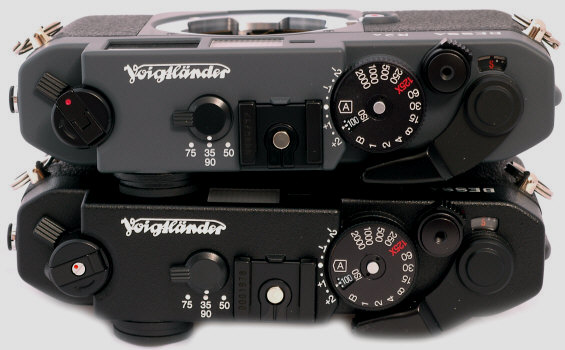
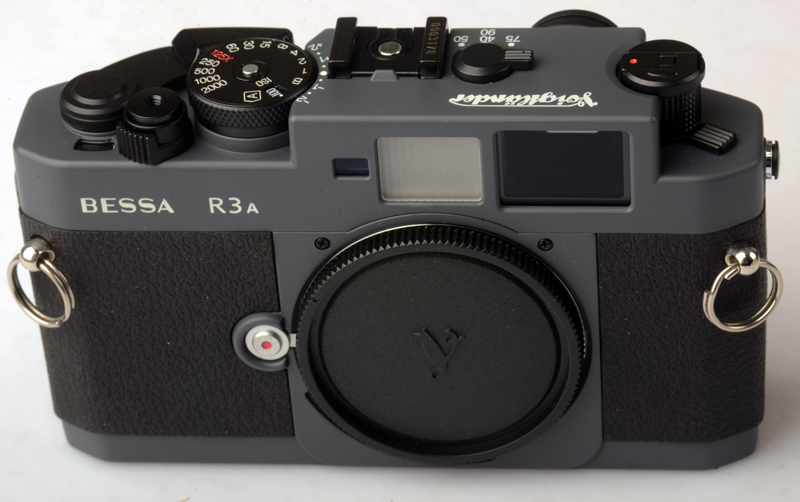
The Grey V2 R2A and the Black V1 R2A. How to tell the difference? Notice the rewind lever. If the R2A/R3A rewind lever has a set screw in the middle of the folded rewind lever, it is a Version 1. Notice the grey Version 2 above it has no set screw in the folded rewind, instead having a jointed folding rewind lever.
Both cameras offer metered manual, or Aperture Priority AE exposure with plus/minus two stops exposure compensation.On AE, the shutter speed dial turns within the plus/minus 2 stop exposure compensation range. To switch to manual exposure, push down the center shutter speed dial button select your manual shutter speed. To change the film speed, raise and rotate the shutter speed dial to the film speed of your choice, which shows in the shutter speed dial window.
AE Exposure Compensation trick:Meter and use AE lock, then adjust the f/stop to compensate as you like, take the shot. It's simple, easy, and fast.
The exposure lock button is on the back of the top plate, allowing the photog to meter where they like, then lock the AE exposure and re-compose for the proper framing. Keep the button depressed to hold the AE exposure. While depressed, the chosen AE exposure will not change in the finder display.
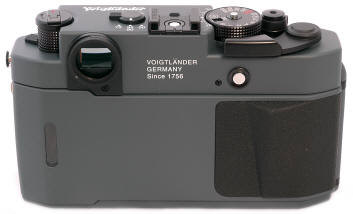
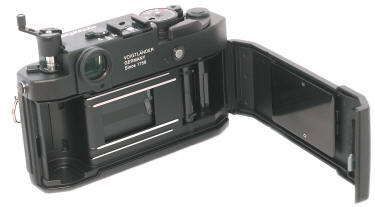
Voigtlander Bessa R2A R3A Specs
- Leica M mount cameras with aperture priority AE or metered manual exposure
- Black or Gray Finish R2A / R3A finish, although the V1 Gray is more common than the V2 Gray.
- The black V1 finish is a bit rough, the black V2 finish is smoother more matt
- The finder is very bright, with a very bright RF focusing patch, as well as bright easy to see framelines.
- R3A Finder 1:1 life size, 40/50/75/90 framelines
- R2A Finder .7 magnification, 35/50/75/90 framelines
- Rangefinder Close Focus .7 meter
- Rangefinder Base length of 37mm: This translates to an effective rangefinder base length of 37mm for the 1.0x magnification R3A, and 25.6 mm(37mm x .68 magnification) for the R2A. In other words, the R3A's rangefinder is 74% as long as the standard .72 Leica M finder, while the R2A's rangefinder is 51% as long as the standard .72 Leica M finder with EBL of 49.32.
- R2A / R3A Rangefinder coupled close focus is .7 meters. If a particular lens allows closer focusing than .9 meters, set focus using the distance scale focusing on the lens barrel.
- Electronic Shutter, 1-1/2000 plus B manually selected speeds, 8-1/2000 on AE
- This Shutter is noticeably quieterthan the mechanical shuttered R2, but not as quiet as a Leica M camera.
- Electronic Flash sync 1/125th, via hot shoe or PC connection at the end of the camera near the rewind lever. It is worth mentioning the PC connection is much better located at the end of the camera, then at the middle of the back of the top plate where it is continually in the way on the Leica M series.
- Like most electronic shutters, if the batteries die, the camera dies. Thankfully the batteries are easy to find SR76, and the camera has low electricity consumption.
- Two 1.5V Alkaline batteries(LR44) or Silver batteries(SR44). I like the R2A/3A electronic shutters powered by only two small easy to find LR44 batteries, not the often hard to find Lithium batteries used by some camera manufacturers.
- Centerweighted TTL Metering for ambient light read off the outer light tight shutter curtains
- Metering in Manual or AE with AE Exposure Lock Yes, unlike the Minolta CLE, the new Bessas have metered manual exposure. YAY !
- EV1-19(ISO 100, F4, 1 sec.-F16, 1/2000 sec), ISO 25-3200
- LED Shutter Speed readout from 1 to 2000 at the bottom of the finder. On manual exposure, the chosen shutter speed dial is lit, while the suggested shutter speed blinks.
- AE Selected shutter speeds are stepless 1/2000th to 8 seconds. The LED speeds indicated in the viewfinder are rounded off.
- The meter display activates after the shutter is advanced and the shutter release is pressed. The display goes out after you shoot, or about 10 seconds after you remove your finger from the shutter release. The red LED readout at the bottom of the finder is easy indoors, but still very usable outdoors.
- Exposure Compensation +/- 2 f/stops on AE, by rotating the shutter speed dial.
- AE Exposure Lock button is located on back of top plate near film advance. Keeping the button depressed with your thumb holds the AE exposure and freezes the finder display.
- Low Batteries are indicated by blinking LEDs at the farthest ends of the shutter speed readout.
- Manually set Film Speed ISO 25 to 3200, no DX
- Manually selected framelines, like the R/R2. The R3A has 75, 40/90, 50 combinations. The R2A has 75, 35/90, 50 combinations.
- Diopters: the new Bessas take the same eyepiece diopters as the Nikon FM3A
- Ratcheting film advance, 45 degree standoff and 120 degree advance stroke
- Rotating shutter lock on shutter release, this takes some getting used to or you may lock the shutter without intending to.
- Size: 135.5(W) x 81(H)x 33.5(D)mm, 430 grams. Side by side, the R2A / R3A are the same size as the previous R2. Both are slightly shorter than a Leica M body, and slightly taller. The Bessa R2A/R3A use the previous Bessa RF cases.
- Takes standard[Bessa Accessory Grips](voigtacc.htm#Bessa camera grips) and [Trigger Winder](voigtacc.htm#Trigger Winder)
- The machined rewind lever is much heavier and stronger than the cast R/R2 rewind lever. To rewind the film, push in the rewind button on the camera, and rewind the film by first raising the end of the rewind lever. When the film is rewind, pull back the lever at the base of the rewind knob, raising the rewind knob to open the camera back.
- Camera Film Back release is a lever located at base of rewind knob.
- Film reminder window on camera back
- 2013 All the Bessa R2A/R3A/R4A cameras were discontinued. The R2M/R3M/R4M cameras remain in production. The grey R2A/R3A were discontinued in 2009 while the black continued on.

Keeping the same 37mm rangefinder base length as R/R2, the R3A's increased magnification to 1:1 means an EBL or Effective Base Length of 37 mm. That is less than the Leica M .58 finder at 40.16 mm, but it is a substantial improvement over the R/R2/R2A at 25.16 mm. For more info on Rangefinders, Viewfinders, and Effective Base Length see RF/VF.
If you are new to rangefinders, or have never tried a 1:1 RF finder, you might not realize what a BIG deal the R3A 1:1 finder is. In practical terms the 1:1 finder just makes shooting and composing tremendously easier and faster because you can always keep both eyes open. Again, the R3A is the only M mount film camera EVER with a 1:1 finder! Yay Mr. K!
No previous Leica mount M film camera has left the factory with a 1:1 finder, whether made by Leica, Konica, Minolta, or Cosina, although the .92 magnification Leica M3 was close. The R3A turns out to be the first 35mm film camera with projected parallax corrected brightlines in a 1:1 finder. There are comparatively few quality interchangeable lens 35mm RF's with 1:1 finders. No other Leica made M film camera, or M clone from Minolta, Konica, or even Cosina Voigtlander has a 1:1 finder. Classic Nikon rangefinder fans are lucky enough to have 1:1 finders in the S2, S3, and S4, but they don't have the luxury of projected bright lines or parallax correction. No classic Zeiss Contax had a 1:1 finder. Classic Leica mount Canon fans enjoyed a 1:1 finder with theCanon P with parallax corrected framelines, but with a mediocre flare prone finder.
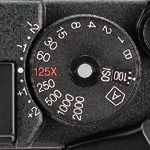
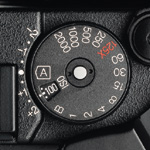
The new Bessas offer manually selected speeds from 1 to 1/2000th plus B, stepless Aperture Priority AE from 8 seconds to 1/2000th, plus/minus 2 stops compensation on AE, manually set film speeds, and flash sync up to 1/125th.
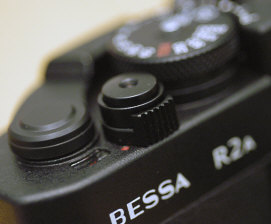
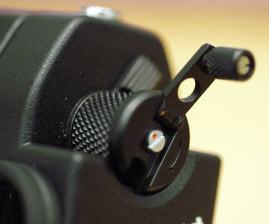
The shutter lock rotates around the shutter release. If you can see the red dot next to the film counter, the shutter is UNLOCKED. If you can NOT see the red dot, the shutter lock is ON. The new machined rewind lever is larger and stronger than the previous stamped rewind found on the Bessa R2. The camera back release catch is at the base of the rewind knob. Push it back and then pull up the rewind lever to open the back. Shown above is the first version RA2A rewind crank, which was replaced by a doubled hinged rewind lever as shown on the blue R3A a bit farther down on this page.
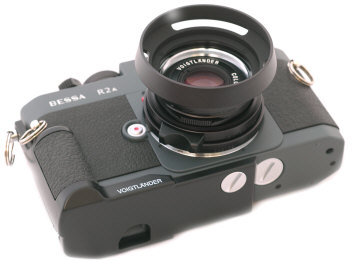
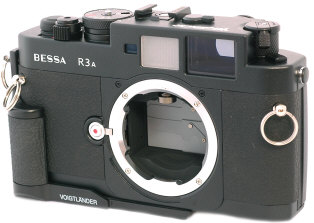
The side grip is one of my favorite Bessa accessories. It fits ALL of the Cosina Voigtlander Bessas.
Notice that like the rest of the Voigtlander line, these new Bessas do not have TTL flash. Mr. K believes RF's are best as available light cameras, not flash cameras. Another reason is that so far it has only been practical to build 35mm rangefinders with basic unsophisticated TTL flash using 1970's technology. In other words, why bother if the TTL flash available in practical terms for rangefinders is not that great, compared to the newest TTL flash for SLRs from Nikon, Canon, or Minolta? Personally I am very surprised to find the new AE Bessas priced this low. I was expecting $200-300 more than the previous R2. Translation: Cosina is steadily improving its rangefinder lineup with more sophisticated designs while keeping cameras affordable.
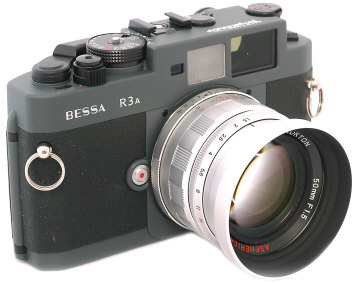
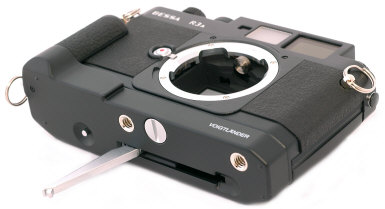
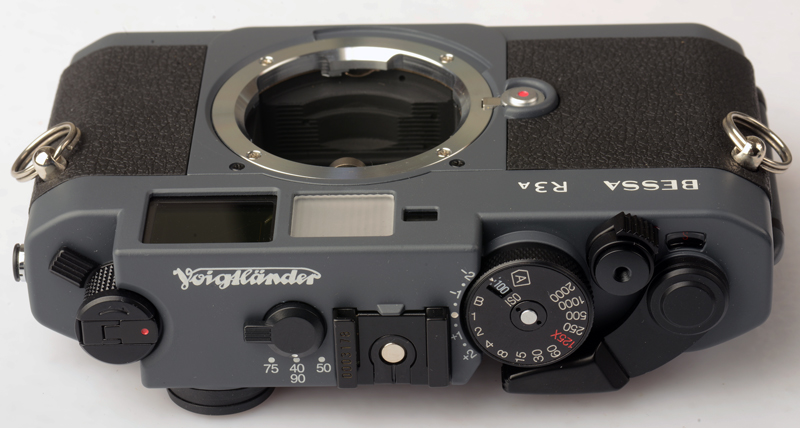
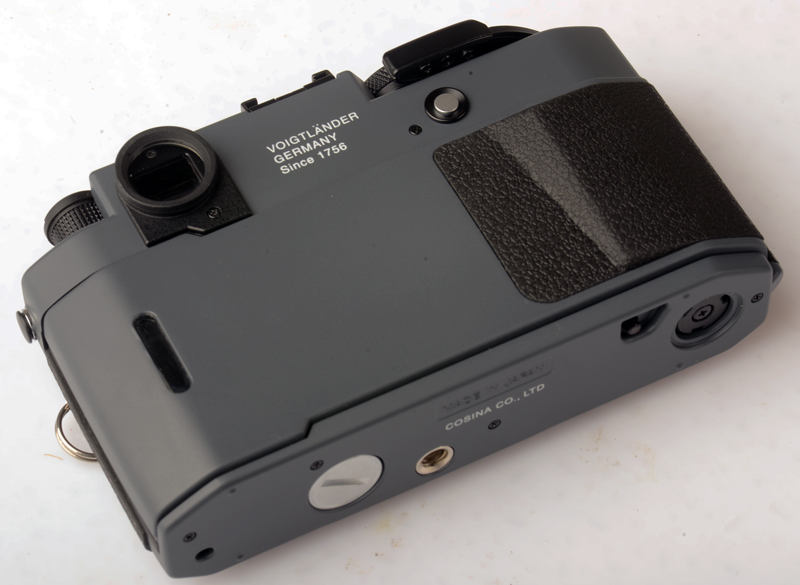
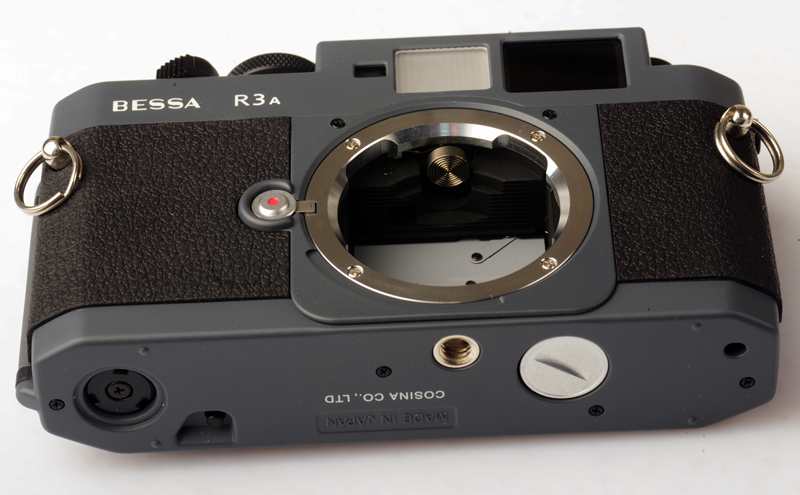
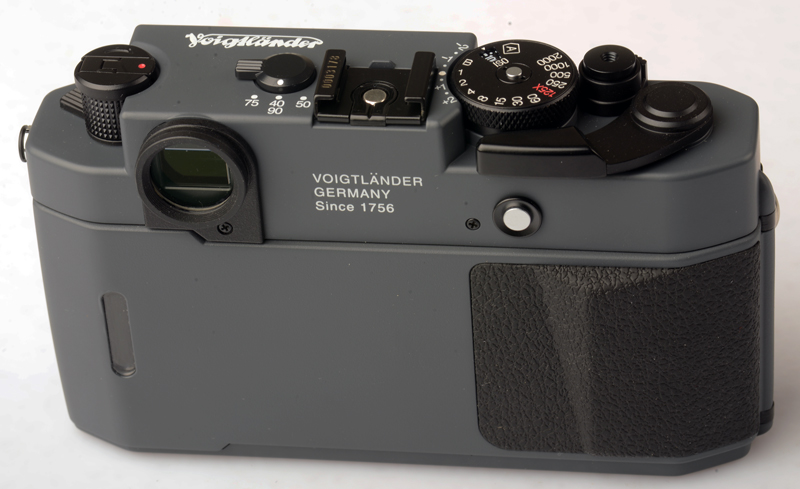
gray Bessa 3A with 50/1.5 Nokton, black Bessa 3A with Trigger Winder
ALSO Introduced with the Bessa R2A/R3A were the 40/1.4 M mount lens, and a new compact clip on VC Meter II for classic meterless cameras.
Voigtlander Eye Candy: Blue Bessa R3A -- one of THREE produced in blue for factory evaluation
What Lenses DON'T fit
Due primarily to the possibility of hitting the Bessa outer shutter, these lenses are NOT recommended:
Leica Hologon 15mm F8 Leica Super Angulon 21mm F3.4 Leica Super Angulon 21mm F4 Leica Elmarit 28mm F2.8 (first model) Leica Dual range Summicron 50mm F2 -- won't mount properly due to internal body restrictions
Russian 20 and 35 screw mount lenses protrude too deeply into the camera
There are probably other lenses which could damage the Bessa's shutter, so exercise good sense and caution when mounting ANY deeply recessed lens or collapsible lens for the 1st time.
Collapsible Lenses
Inside the lens chamber you will see round cut out ledges at the top and bottom , about 3mm in front of the shutter. These cut outs are apparently designed to act as a "lens stop" when a collapsible lens is pushed back into the body. Note it is just a metal shield. Push in collapsible lenses GENTLY. If you really slam lenses in there with some force, it's my guess you will eventually get some metal shavings stuck in your shutter.
I'm told the 50/2 Collapsible Summicron and current version of the new version 50/2.8 Elmar can be collapsed into the Bessa body without any damage to the camera or lens -- but be careful since there are lens variations.
The original version 50/2.8 Elmar can also be collapsed, but not completely. The telescoping barrel will make contact with a ledge inside the lens chamber, stopping the lens 3mm short of collapsing completely.
The 50/3.5 Elmar screw mount (1954) will collapse, but stops about 1/4" out as it hits a ledge inside the lens chamber. There are many collapsible lenses, so be careful when collapsing a lens the 1st time least you damage camera or lens !!
Personally my favorite collapsible Leica lens is the uncoated 50/2 Summar, made between 1933 to 1940. It gives beautiful semi-soft focus effects and muted colors wide open to about f/4 -- great for landscapes or women. Happily, the Summar fits just fine on the Bessa (with a screw mount to bayonet mount adapter), collapsing almost completely into the body.
There are probably some collapsible or deeply recessed lenses which could damage the Bessa's shutter, so exercise good sense and caution when mounting ANY deeply recessed lens or collapsible lens for the 1st time. Even the collapsible lenses listed here as being OK do have an unknown number of variations. Remember to push in collapsible lenses GENTLY to avoid problems.
The collapsible Voigtlander 50/2 Heliar CAN be safely collapsed into ALL Cosina Voigtlander Bessas.
Bottom Line: The Voigtlander Bessa R3A and R2A are damned nice cameras, easily best buys in AE Leica M cameras as far as I am concerned. This shot of a prototype was taken at Photokina 2004. Out of the picture on the other side of the table is Mr. K.
Voigtlander Bessa R2A or R3A ?
The R2A / R3A bodies are identical, except for the viewfinders. The R2A has a .7x magnification viewfinder with 35/50/75/90 framelines. The R3A has a 1.0x magnification viewfinder with 40/50/75/90 framelines.
The advantage of the R2A is the 35 frameline, and that IF you don't wear glasses, some people use the full frame of the viewfinder for an approximation of a 28mm field of view -- although the hot shoe mounted 28 accessory viewfinder does a better job.
The advantage of the R3A is the life-size 1.0x magnification viewfinder. This means that if you focus with your right eye, you can shoot with both eyes open, giving you full periphery viewing far beyond the framelines with less eye strain. And of course, the 40 frameline mates perfectly with the very popular Voigtlander 40/1.4 Nokton. With the higher magnification, you also get slightly more accurate focusing as the R3A has a longer effective rangefinder base length than the lower magnification R2A. IF you don't wear glasses, you may find it useful to use the entire full R3A viewfinder as a 35mm field of view.
The disadvantage of the R3 A to some glasses wearers is trouble seeing all four edges of the 40 frameline. This problem increases with the thickness of your glasses. Yet many people who are bothered by this are expecting SLR like viewing accuracy from the framelines. In fact framelines in all Leica mount cameras (regardless of camera manufacturer) are more like approximations as they show the minimum you will get on film when the camera is focused at its closest focus distance. At infinity, you always get more than what the framelines show. Bottom line, it depends upon your glasses and what works with you. Even if you wear thick glasses, you will likely have no problem seeing the 50/75/90 R3A framelines.
R2A /R3A vs. R2M / R3M?
These four cameras are produced in the same factory on the same assembly line by the same personnel, using the same body casting. They differ primarily in their shutters and Aperture Priority Exposure vs. Metered Manual Exposure.
The R2A / R3A have electronic shutters which makes possible your choice of either metered manual metering (you adjust the f/stops or shutter speeds to match the finder readout) or Aperture Priority Automatic Exposure (you choose the f/stop, the camera automatically chooses the shutter speed) with AE exposure lock. The R2A / R3A offer faster shooting with Aperture Priority -- a big plus for street photography or quick moving events. The disadvantage is like virtually all other electronic shutter cameras, dead batteries mean a dead camera.
The R2M / R3M have mechanical shutters, which means no Aperture Priority AE. Dead batteries mean no meter, but you can continue to take pictures by setting the exposure yourself. In my opinion the R2M / R3M have the best metered manual metering display of ANY Leica mount rangefinder. In addition, the R2M / R3M shutters are noticeably quieter than the earlier mechanical shutters of the Bessa L, T or R2, but yet not as quiet as the cloth shutters in the Leica M series.
The R2M / R3M 250th Anniversary cameras are relatively rare limited edition cameras produced in either silver paint or classic black paint. The R2A / R3A are standard production cameras, produced in either black splatter paint or gray paint. The R2M / R3M have a LED meter readout in plus / - half stops from -2 to +2. The R2A / R3A have a LED meter readout indicating the closest selected shutter speed.
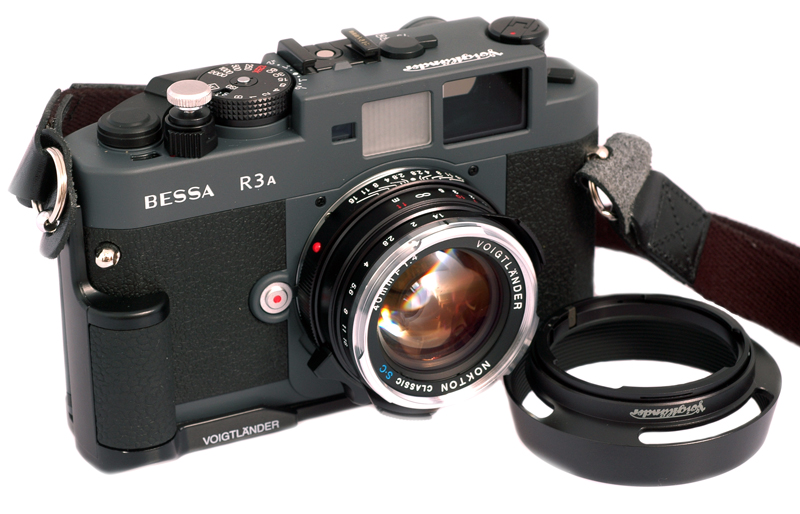
MY FAVORITE VOIGTLANDER ACCESSORY PACKAGE: the side grip, deluxe strap, and Abrahamsson Mini-Soft Release. This particular camera outfit was given away in the 2006 DeviantArt - Chris Week - CameraQuest Street Photography Contest. The gray color R3A and R2A are discontinued, but the gray R2A is still in stock. Black remains in production.
Which to Choose? Order Here
Buy the Bessa which suits YOUR needs best. Only you can decide that. The best Bessa for your best friend may or may not be the best camera for YOU.
Prices Voigtlander System Bessa Chart Bessa R3M / R2M Bessa R2A/R3A Bessa T Heliar 101 101 PICS Bessa T intro Bessa T T or IIIf? Bessa R Bessa L Bessa L/A Lenses 35/1.2 21/25 Shade
Accessories VC Meter II MiniSoftrelease Bessa R2S & R2C SC Lens Intro SC Lenses SL Lenses SL 12&15 Lenses Prominent 50mm Lens Adapter
CameraQuest Home Shopping Cart Price List Camera Articles I Buy / Wants Repairs Books Adapters
Revised: March 15, 2018 . Copyright � 2004-14 Stephen Gandy. All rights reserved. This means you may NOT copy and re-use the text or the pictures in ANY other internet or printed publication of ANY kind. Information in this document is subject to change without notice. Other products and companies referred to herein are trademarks or registered trademarks of their respective companies or mark holders.
